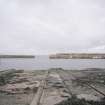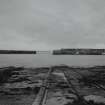Pricing Change
New pricing for orders of material from this site will come into place shortly. Charges for supply of digital images, digitisation on demand, prints and licensing will be altered.
Upcoming Maintenance
Please be advised that this website will undergo scheduled maintenance on the following dates:
Thursday, 9 January: 11:00 AM - 3:00 PM
Thursday, 23 January: 11:00 AM - 3:00 PM
Thursday, 30 January: 11:00 AM - 3:00 PM
During these times, some functionality such as image purchasing may be temporarily unavailable. We apologise for any inconvenience this may cause.
Cockenzie Harbour
Harbour (17th Century) - (19th Century)
Site Name Cockenzie Harbour
Classification Harbour (17th Century) - (19th Century)
Alternative Name(s) 'Cockeny Hauen'; Firth Of Forth; Outer Forth Estuary
Canmore ID 53645
Site Number NT37NE 3
NGR NT 39770 75694
Datum OSGB36 - NGR
Permalink http://canmore.org.uk/site/53645
- Council East Lothian
- Parish Tranent
- Former Region Lothian
- Former District East Lothian
- Former County East Lothian
NT37NE 3.00 39770 75694
Cockenzie Harbour
Piers [NAT]
OS 1:10,000 map, 1991.
NT37NE 3.01 NT 39844 75582 Boatyard; Slipway
NT37NE 3.02 NT 398 757 Salt Pans
NT37NE 3.03 NT 399 757 Trial Excavation (saltworks, 2002)
NT37NE 3.04 NT 39858 75696 Buildings
Location formerly entered as NT 3977 7563.
Not to be confused with Port Seton Harbour (NT 40487 75947), for which see NT47NW 18.
Cockenzie harbour is depicted on the1st edition of the OS 6-inch map (Haddingtonshire 1854, sheet 9), and described in the Object Name Book of the Ordnance Survey as 'A small harbour at the W side of Cockenzie at a natural basin. It was constructed in 1855 by Messrs Cadell at a cost of about 400 pounds. The harbour has 16ft depth of water in spring tides, and 10' in neap tides. It affords an easy access for vessels, from it coals are exported to England, France, Germany and the Northern parts of Scotland' (ONB 1853).
(Undated) information in NMRS.
OS Name Book 1853.
(Location cited as NT 398 756). Cockenzie, East Lothian: Cockenzie is on record in 1565 and in 1592, at the latter date as a free haven. Blaeu's map marks 'Cockeny hauen' and shows two projections, presumably representing piers, and these may be correlated with the harbour begun by the 3rd Earl of Winton, about 1630, in connection with his salt-pans. This work is said to have been destroyed by a storm, but the place must have continued in use, as a document probably datable to the turn of the century lists Cockenzie as a 'sea harbour', while Adair (1703) records 'a harbour within a stone Peir', although noting that it was going out of use on account of the narrowness of the entrance. The York Buildings Company renovated and enlarged the harbour in 1722, and built a railway from it to the Tranent colliery, some remains of which may still be seen S of the village in square NT 40 74. Colliery and harbour were bought by John Caddell in 1774, and the harbour was rebuilt by Messrs Caddell to plans by Messrs Robert Stevenson and Sons, being completed in 1833.
The harbour occupies a tidal pocket of mud and flat rock, partially protected by a pair of rock ridges which extend across its front from E to W and give access to it through a gap between their ends. On the E ridge, there stands a breakwater-quay 227ft [69.2m] long with a returned pier-head; it is built of squared red sandstone blocks in courses, with some rusticated work in parts of the seaward face. The parapet is up to 8ft 6ins [2.6m] high by 2ft [0.6m] thick, and is secured along the top with a stout iron strap. The W breakwater has rusticated masonry in its terminal portion and a patch of vertically set slabs further in, no doubt representing a repair. In spite of minor differences in masonry, there is no reason to doubt that the whole work, including the cuttings of underlying rock that appear from place to place, is substantially of the period of the Caddells' reconstruction. The entrance is 90ft [27.4m] wide, and the enclosed area amounts to slightly over 5 acres [2ha].
A Graham 1971.
(Location cited as NT 398 757). Cockenzie Harbour, rebuilt in its present form 1835, engineers Robert Stevenson and Sons. Formed by an L-plan E pier and a W breakwater, both rubble-built, the latter patched in several places.
J R Hume 1976.
Earlier harbour remains incorporated into design by Robert Stevenson, 1835. This is still in use as a harbour and it is generally in good condition and well maintained. A section of early stone walling can be seen.
Site recorded by GUARD during the Coastal Assessment Survey for Historic Scotland, 'The Firth of Forth from Dunbar to the Coast of Fife' 22nd February 1996.
Photographic Survey (September 1962)
Survey of Cockenzie Harbour by the Scottish National Buildings Record in 1962
Field Visit (22 February 1996)
Earlier harbour remains incorporated into design by Robert Stevenson, 1835. This is still in use as a harbour and it is generally in good condition and well maintained. A section of early stone walling can be seen.
Site recorded by GUARD during the Coastal Assessment Survey for Historic Scotland, 'The Firth of Forth from Dunbar to the Coast of Fife' 22nd February 1996.
Note (December 2007)
Cockenzie harbour is depicted on the1st edition of the OS 6-inch map (Haddingtonshire 1854, sheet 9), and described in the Object Name Book of the Ordnance Survey as 'A small harbour at the W side of Cockenzie at a natural basin. It was constructed in 1855 by Messrs Cadell at a cost of about 400 pounds. The harbour has 16ft depth of water in spring tides, and 10' in neap tides. It affords an easy access for vessels, from it coals are exported to England, France, Germany and the Northern parts of Scotland' (ONB 1853).
Publication Account (2007)
Cockenzie Harbour is thought to have been originally begun by the Earl of Winton, probably in 1630, for the export of coal and salt. The Earl of Winton, who supported the Jacobite rebellion in 1715, forfeited his estate which was acquired by the York Buildings Company in 1719. In 1722 the Earl repaired and enlarged the harbour and constructed a wooden wagonway, one of the earliest in Scotland, for the export of coal from coal pits at Tranent some two miles inland to the east side of the harbour. The wagonway featured as a strategic element in the battle of Prestonpans.
In 1774 both the harbour and colliery were bought by the Cadell family, co-founders of the epoch-making Carron
Ironworks in 1759. The harbour, of about five acres, was extensively rebuilt in 1833–34 to plans prepared by Robert Stevenson & Sons for the Cadells. It is essentially a tidal pocket of sand and flat rock, flanked and partially protected by ridges of rock. The east ridge carries a main breakwater pier 227 ft long and about 30 ft wide and 30 ft high with a returned head, built of squared red sandstone blocks and, across an entrance (out of sight to the left in the view) of about 90 ft; the west ridge carries a narrower pier of similar construction. The stone used on the works was found in the harbour basin which considerably reduced their cost, which did not much exceed £5000. The harbour, a good example of a small coal port, was much used for several decades but by the 1880s ships had outgrown the facilities, coal was transported by rail to other ports, and the wagonway was closed after more than 160 years in operation. The piers were extended and refurbished in the 1960s. The harbour is still used in a small way but its boat building and slipway use ceased in ca.1995.
R Paxton and J Shipway 2007
Reproduced from 'Civil Engineering heritage: Sdotland - Lowlands and Borders' with kind permission of Thomas Telford Publishers.
Remote Operated Vehicle Survey (November 2021)
NT 39771 75654 In November 2021 an aerial survey of Cockenzie Harbour was completed and the collected data used to produce a photogrammetric model of the harbour. Plans, sections, and elevations of the harbour were produced from this model. This was part of a wider Conservation Management Plan (CMP) for the harbour, funded by the Historic Environment Scotland Year of Coasts and Waters grant. The survey was completed using a DJI Inspire 2 drone by two CAA-qualified pilots in November 2020, with the outputs being processed and digitised during the winter of 2020/21. The results informed the CMP of the current condition of the fabric of the harbour, as well as identifying areas of disrepair. Archive NRHE (intended)
Funder: East Lothian Council
Ben Saunders – Wessex Archaeology
(Source: DES Vol 22)
Magnetometry (23 March 2023 - 24 March 2023)
The cart-based gradiometer system used a Leica Captivate RTK GNSS instrument, which receives corrections from a network of reference stations operated by the Ordnance Survey (OS) and Leica Geosystems. Such instruments allow positions to be determined with a precision of 0.02 m in real-time and therefore exceeds European Archaeologiae Consilium recommendations (Schmidt et al. 2015). The detailed gradiometer survey was conducted using a non-magnetic cart fitted with four SenSys FGM650/3 magnetic gradiometers. The instrument has four sensor assemblies fixed horizontally 1 m apart allowing four traverses to be recorded simultaneously with an effective sensitivity of 0.03 nT over a ±100 nT range. Data was collected at 0.08 m intervals along transects spaced 1 m apart, in accordance with European Archaeologiae Consilium recommendations (Schmidt et al. 2015). Data was collected in the zigzag method. Ground Penetrating Radar The survey was conducted using an Impulse Radar Crossover 4080 system with a dual frequency antenna. The Crossover 4080 antenna is mounted on a rough terrain cart which is fitted with an odometer to measure horizontal distance along the ground surface. This was be deployed across the GPR areas within Cockenzie Harbour Wall East and the area south-west, with data collected along traverses spaced 0.5 m apart. Survey of the harbour wall produced evidence of an earlier construction phase of the harbour. The line of the earlier dock wall is denoted by a straight delineation in the data. The high amplitude point reflectors west of this line display the later construction phase during the remodel by Stevenson. The position of a former cottage may be highlighted within the eastern end of the harbour wall. While this corresponds with visible remains of the cottage, this response may be attributed more to water retention within the footprint of the former building. There is evidence of water retention at various depths in immediate vicinity of the southern and northern wall faces the in the wall. Part of these responses also coincides with the former position of a crane. Although not always clear, evidence for the potential tie wall locations have been identified within the data. These correspond to the plans produced by Stevenson during construction. The gradiometer survey areas have produced very limited evidence of possible archaeological activity associated with the Wagonway. This comprises a small rectilinear enclosure. Highly contrastive magnetic values impair further archaeological interpretation, possibly as a result of the industrial activity from the Wagonway coal industry through to the demolition of Cockenzie power station. The remaining anomalies are thought to be modern. These include demolition material, footpaths, services, and a garden feature identified in the Memorial Garden.
Information from OASIS ID: wessexar1-516869 (B Howard) 2023








































































































